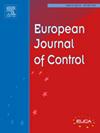A widely-practical model-free prescribed time control for trajectory tracking of n-DOF robot manipulators
IF 2.6
3区 计算机科学
Q2 AUTOMATION & CONTROL SYSTEMS
引用次数: 0
Abstract
This paper proposes a novel, practical prescribed-time control (PTC) scheme for the trajectory tracking of n-degree-of-freedom (n-DOF) robot manipulators subject to external disturbances. Unlike existing approaches, the proposed PTC scheme is entirely model-free. It leverages a time-delay estimation (TDE) technique to compensate for unknown dynamics and disturbances, eliminating the need for upper bounds. A key innovation is the design of a new time-varying gain which increases only as the time approaches the prescribed value. This ensures the feasibility of the control signal and avoids saturation issues which often make practical deployment difficult. The controller also remains effective beyond the prescribed time, overcoming a significant limitation of previous studies. Rigorous Lyapunov analysis guarantees that position and velocity tracking errors will converge within the prescribed time. Comparative simulations on a parallel Delta robot demonstrate the superiority and practicality of the scheme over existing methods.
一种广泛应用于n-DOF机器人机械臂轨迹跟踪的无模型规定时间控制
提出了一种新颖实用的n自由度(n-DOF)机器人运动轨迹跟踪的规定时间控制(PTC)方案。与现有的方法不同,拟议的PTC方案是完全无模型的。它利用时延估计(TDE)技术来补偿未知的动态和干扰,消除了上界的需要。一个关键的创新是设计了一种新的时变增益,它只在时间接近规定值时增加。这确保了控制信号的可行性,并避免了通常使实际部署困难的饱和问题。该控制器在规定时间之外仍然有效,克服了以往研究的显著局限性。严格的李亚普诺夫分析保证了位置和速度跟踪误差在规定时间内收敛。通过对并联Delta机器人的仿真对比,验证了该方案相对于现有方法的优越性和实用性。
本文章由计算机程序翻译,如有差异,请以英文原文为准。
求助全文
约1分钟内获得全文
求助全文
来源期刊

European Journal of Control
工程技术-自动化与控制系统
CiteScore
5.80
自引率
5.90%
发文量
131
审稿时长
1 months
期刊介绍:
The European Control Association (EUCA) has among its objectives to promote the development of the discipline. Apart from the European Control Conferences, the European Journal of Control is the Association''s main channel for the dissemination of important contributions in the field.
The aim of the Journal is to publish high quality papers on the theory and practice of control and systems engineering.
The scope of the Journal will be wide and cover all aspects of the discipline including methodologies, techniques and applications.
Research in control and systems engineering is necessary to develop new concepts and tools which enhance our understanding and improve our ability to design and implement high performance control systems. Submitted papers should stress the practical motivations and relevance of their results.
The design and implementation of a successful control system requires the use of a range of techniques:
Modelling
Robustness Analysis
Identification
Optimization
Control Law Design
Numerical analysis
Fault Detection, and so on.
 求助内容:
求助内容: 应助结果提醒方式:
应助结果提醒方式:


